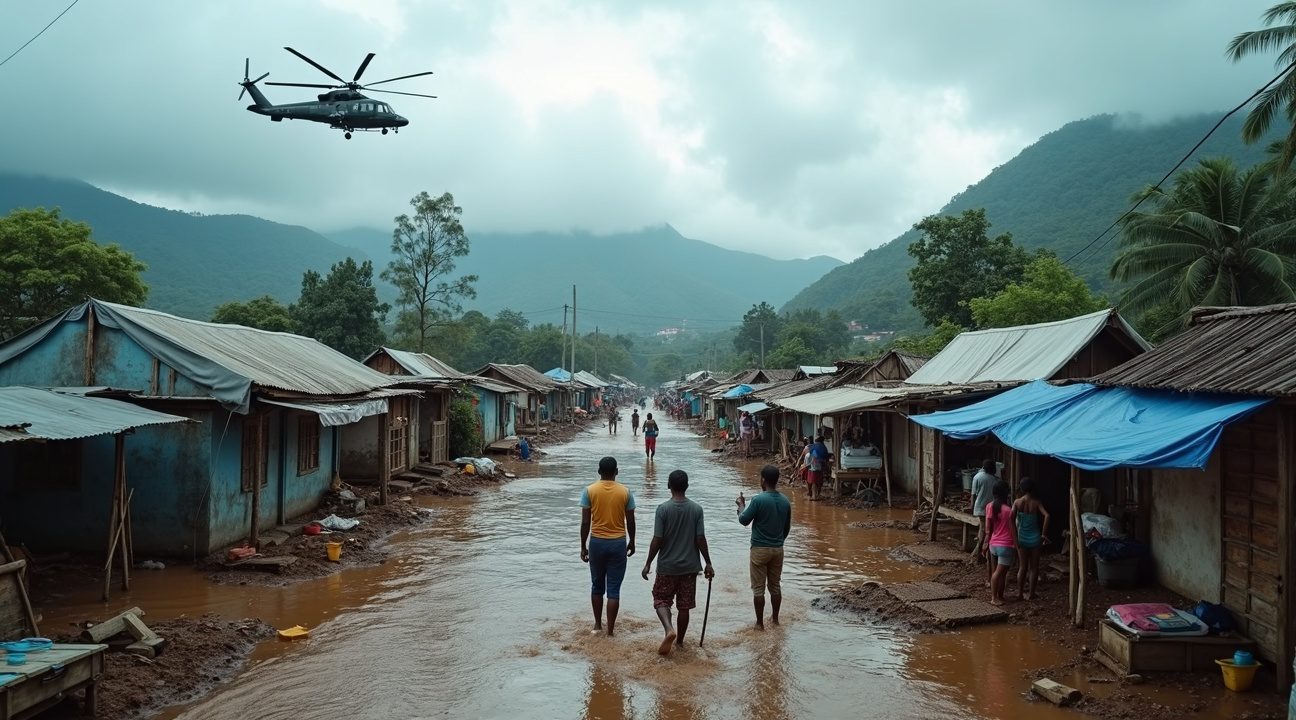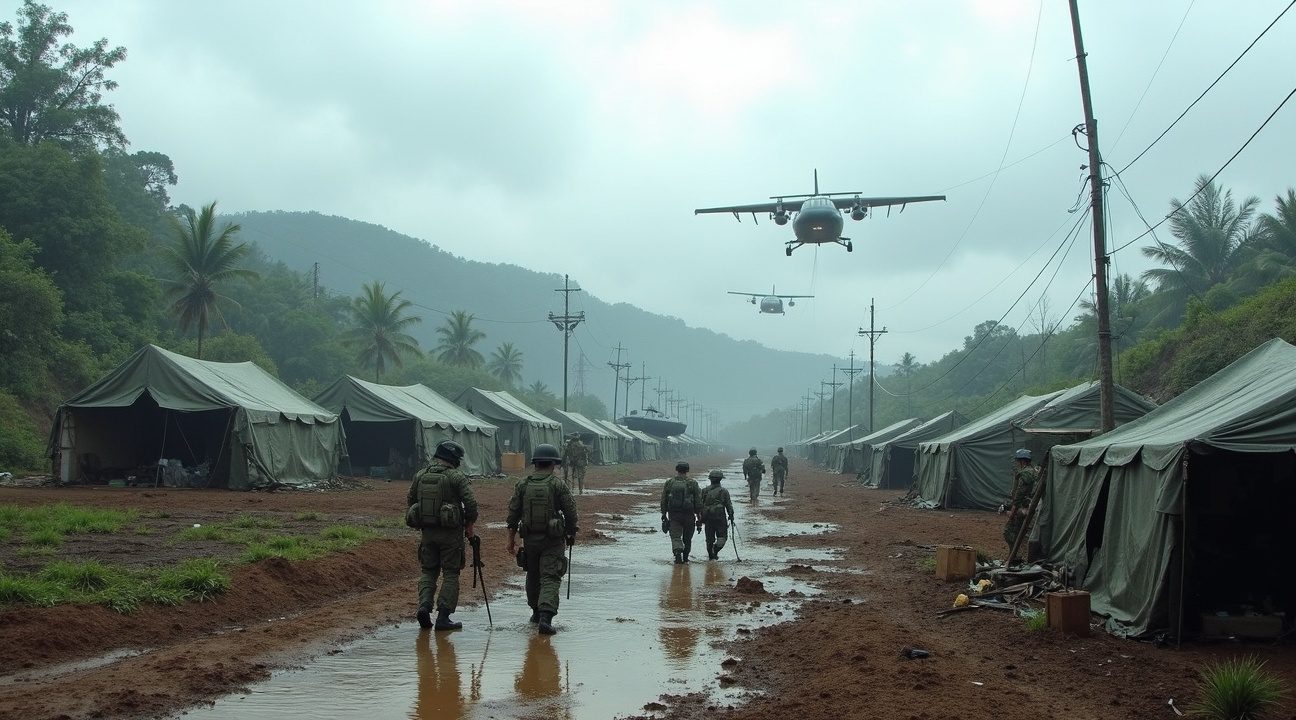The United States has allocated $1 million in emergency disaster relief assistance to the Philippines as the country grapples with the aftermath of three consecutive natural disasters that have severely impacted millions of people.
Key Takeaways
- The US is providing $1 million in emergency relief funding focused on emergency shelter, logistics services, clean water and sanitation, and coordination with local Philippine efforts.
- Three consecutive disasters — Typhoon Tino, a magnitude 6.9 earthquake in Cebu, and Super Typhoon Uwan — have affected 8.3 million Filipinos and displaced over 1.4 million individuals.
- US Indo-Pacific Command has deployed military personnel and assets including transportation aircraft, communication equipment, and specialized disaster response teams to support relief efforts.
- The assistance builds on a decade-long partnership that began after Super Typhoon Haiyan in 2013, fostering improved disaster management frameworks and response protocols.
- International humanitarian organizations such as the World Food Programme and Action Against Hunger are actively providing aid, with the U.S. support amplifying these ongoing efforts.
Strategic Support Through Military and Humanitarian Channels
The involvement of the US Indo-Pacific Command reflects a strategic approach combining military capabilities with humanitarian assistance. Aircraft, communication gear, and disaster response units are currently operating in concert with Philippine authorities to deliver timely relief to affected areas.
A Legacy of Partnership
This latest response continues a strong partnership initiated in the aftermath of Super Typhoon Haiyan in 2013. Over the years, training programs, joint disaster preparedness drills, and infrastructure support have bolstered the Philippines’ resilience to natural catastrophes.
The allocation of resources in this emergency underscores the ongoing commitment of the United States to regional stability, humanitarian relief, and collaborative disaster management in Southeast Asia.
Three Consecutive Disasters Leave 8.3 Million Filipinos in Crisis
The Philippines has faced an unprecedented series of natural disasters over recent months, creating a humanitarian emergency that has overwhelmed the nation’s capacity to respond effectively. I’ve observed how three major catastrophic events struck in rapid succession, each compounding the devastation left by the previous disaster.
Devastating Impact of Three Major Disasters
Typhoon Tino (Kalmaegi) delivered the first devastating blow to the Southern Philippines, claiming at least 188 lives while leaving 135 people missing. This powerful storm displaced close to 500,000 individuals, destroying homes and infrastructure across multiple provinces. Communities that had previously shown resilience found themselves struggling to cope with the massive scale of destruction.
Shortly after, on September 30, a magnitude 6.9 earthquake struck Cebu, adding another layer of crisis to an already strained situation. The earthquake proved particularly deadly due to the flash floods it triggered, resulting in 139 fatalities. Critical infrastructure suffered significant damage, making rescue and relief operations increasingly challenging for emergency responders.
Super Typhoon Uwan (Fung-Wong) then battered Luzon and Visayas during the weekend preceding November 13, demonstrating nature’s relentless assault on the archipelago. This storm led to 27 additional deaths while displacing thousands more people who were still recovering from previous disasters. The timing couldn’t have been worse, as communities had barely begun to rebuild from earlier catastrophes.
Unprecedented Scale of Human Displacement
The cumulative effect of these three disasters has created a crisis of staggering proportions. Combined impact statistics reveal that over 8.3 million people have been affected by these consecutive natural disasters. More than 1.4 million individuals remain displaced from their homes, creating massive pressure on emergency shelters and temporary accommodation facilities.
I find it remarkable how quickly the situation escalated beyond normal disaster response capabilities. Emergency services, which typically handle single-event disasters effectively, faced the unprecedented challenge of managing multiple ongoing crises simultaneously. Local government units struggled to coordinate relief efforts while dealing with their own damaged infrastructure and depleted resources.
President Ferdinand Marcos Jr. recognized the severity of the situation by declaring a state of national emergency in response to the widespread impact. This declaration enables the government to mobilize additional resources and streamline emergency response procedures across affected regions. The decision reflects the administration’s acknowledgment that standard disaster response protocols weren’t sufficient for such an extraordinary series of events.
International attention has focused on the Philippines due to the unprecedented nature of these consecutive disasters. The sheer number of affected individuals has drawn comparisons to some of the largest humanitarian crises in recent memory. Relief organizations note that the displacement figures approach levels typically seen only in conflict zones or after catastrophic single events like major earthquakes or super typhoons.
Recovery efforts face significant challenges as communities attempt to rebuild while remaining vulnerable to additional natural disasters. The Philippines’ location in the Pacific Ring of Fire and typhoon belt means that affected areas remain at risk for future seismic activity and severe weather events. Emergency planners must balance immediate relief needs with long-term resilience building to prevent similar widespread devastation in the future.
Relief agencies report that the consecutive nature of these disasters has created unique logistical challenges. Traditional disaster response assumes a single event followed by recovery time, but the rapid succession of catastrophes has prevented normal recovery cycles. This situation has led to innovative approaches in emergency management and highlighted the need for adaptive response strategies in disaster-prone regions.
US Announces $1 Million Emergency Relief Package for Life-Saving Aid
The United States has stepped forward with $1 million in emergency disaster relief assistance for the Philippines, demonstrating America’s commitment to supporting allies during critical humanitarian crises. This funding comes as Filipino communities continue recovering from multiple devastating natural disasters that have struck the archipelago nation in recent months.
The assistance package targets the most pressing needs on the ground. The relief funding will concentrate on four essential areas that make the difference between life and death for affected populations:
- Emergency shelter: Providing displaced families with safe places to stay while they rebuild their lives.
- Logistics services: Ensuring that aid reaches even the most remote communities efficiently.
- Clean water and sanitation: Preventing disease outbreaks that often follow natural disasters.
- Coordination with local efforts: Enhancing the delivery and effectiveness of aid distribution nationwide.
Coordinated Response Through Local Partnerships
The US government isn’t working alone in this relief effort. American officials are coordinating closely with the Philippine government and established local organizations to maximize the impact of every dollar spent. This collaborative approach ensures that assistance flows directly to communities that need it most, rather than getting tied up in bureaucratic delays.
Local partnerships prove crucial during disaster response because community organizations understand the specific challenges their regions face. They know which areas remain inaccessible, which families have lost everything, and where immediate intervention can save lives. The US strategy recognizes this expertise and builds on existing networks rather than creating parallel systems that might compete for limited resources.
Targeted Support for Multiple Disaster Zones
The relief package addresses damage from three separate catastrophic events that have pummeled different regions of the Philippines. Communities affected by these disasters will receive targeted life-saving support based on their specific circumstances and needs:
- Areas devastated by Typhoon Tino continue dealing with widespread flooding and infrastructure damage that has cut off supply lines.
- Regions hit by Super Typhoon Uwan face extensive destruction of homes and critical facilities, leaving thousands without basic shelter.
- Communities impacted by the Cebu earthquake are struggling with damaged water systems and compromised sanitation infrastructure.
- Remote islands and coastal areas affected by multiple events require immediate logistics support to restore communication and transportation links.
Each affected zone presents unique challenges that require different approaches. Typhoon-damaged areas might need temporary bridges and emergency power systems, while earthquake zones could require specialized equipment for safe water distribution. The flexibility built into this assistance package allows responders to adapt their efforts based on real-time assessments and changing conditions.
This funding comes at a critical time when the Philippines continues to demonstrate remarkable resilience despite facing repeated natural disasters. The country’s geographic location makes it particularly vulnerable to both seismic activity and severe weather events, creating ongoing humanitarian challenges that strain local resources.
Emergency shelter components of the aid package will likely include emergency tents, temporary housing materials, and essential household items for families who lost everything. Logistics support encompasses transportation services, communication equipment, and coordination tools that help other relief organizations work more effectively. Water and sanitation programs typically involve emergency water purification systems, temporary sanitation facilities, and hygiene supplies that prevent disease transmission in crowded evacuation centers.
The timing and scale of this assistance reflect America’s recognition that natural disasters don’t respect borders, and helping allies recover strengthens regional stability. When countries like the Philippines can respond effectively to disasters and bounce back quickly, it benefits the entire region’s economic and political stability.
This $1 million commitment represents more than financial support – it demonstrates the kind of international cooperation that makes disaster response more effective. By working through established channels and respecting local expertise, the US ensures that this assistance will have maximum impact for Filipino families who are working to rebuild their communities. The focus on immediate life-saving needs shows an understanding of what matters most during the critical hours and days following a disaster, when swift action can mean the difference between recovery and prolonged suffering.

Military Assets and Personnel Deploy for Rapid Response Operations
The United States has mobilized significant military resources to support disaster relief efforts in the Philippines through a coordinated deployment involving multiple branches and commands. US Indo-Pacific Command has taken the lead in organizing this comprehensive response, working directly with US Marines and other military personnel to establish rapid support systems for affected regions.
Mission planning commenced on November 5, setting the foundation for what would become an extensive collaborative effort between American forces and their Philippine counterparts. The Armed Forces of the Philippines has been instrumental in coordinating ground-level operations, while local disaster managers provide essential knowledge about community needs and infrastructure challenges. The State Department facilitates diplomatic coordination to ensure seamless integration of relief efforts across all participating organizations.
Coordinated Relief Operations Expand Beyond Initial Planning
Direct deployment of personnel and critical assets has transformed initial planning efforts into active field operations providing essential logistics and communications support. These deployments focus on disaster-stricken areas where communication networks have been compromised and supply chains disrupted. Military personnel establish communication hubs that connect isolated communities with relief coordination centers, while logistics teams work to restore supply routes for emergency supplies.
The current mission represents the second US military-led relief operation in the Philippines during 2025, building on experience gained from a similar deployment in July that responded to earlier typhoons and monsoon flooding. This previous experience has proven valuable in streamlining coordination protocols and improving response times for current operations.
Military assets deployed include:
- Transportation aircraft
- Communication equipment
- Specialized personnel trained in disaster response operations
These resources complement existing Philippine capabilities rather than replacing them, creating a force multiplication effect that enhances overall relief capacity. Communication systems established by US forces enable better coordination between international relief organizations, government agencies, and local community leaders.
The collaborative approach demonstrates how military partnerships can extend beyond traditional security cooperation into humanitarian assistance and disaster relief. Personnel from both nations work side-by-side in joint operations centers, sharing intelligence about affected areas and coordinating resource allocation to maximize impact. This joint approach has proven particularly effective in reaching remote communities that might otherwise remain isolated during the critical early phases of disaster response.

International Humanitarian Organizations Scale Emergency Response
The US emergency assistance amplifies critical work already underway by international humanitarian organizations responding to the disaster. This coordinated approach demonstrates how strategic partnerships can strengthen relief operations and reach more affected communities across the Philippines.
Major Relief Operations Already in Progress
The World Food Programme has already established substantial support networks throughout the affected regions. Their emergency cash transfers have reached 210,000 people, providing immediate purchasing power for essential supplies. Additionally, the organization has distributed 187,000 food packages, creating a safety net that benefits nearly 1 million individuals facing food insecurity.
Action Against Hunger has deployed specialized response teams to critical provinces including Cebu, Dinagat Islands, and Negros Occidental. These teams focus on delivering comprehensive support that includes:
- Clean water access and sanitation facilities to prevent disease outbreaks
- Emergency shelter materials for displaced families
- Direct cash assistance for immediate needs
- Water treatment and hygiene education programs
Similar to how communities have witnessed surprising turns of fortune in other contexts, such as lottery winners in the Philippines, the scale of international assistance has brought unexpected relief to disaster-affected areas.
Growing Calls for Enhanced International Support
Humanitarian leaders emphasize the need for expanded international backing to match the scope of the emergency. The current response, while significant, requires additional resources to address the full extent of the disaster’s impact across multiple provinces.
Organizations are specifically requesting life-saving aid that can be deployed rapidly to remote and hard-to-reach communities. This includes:
- Medical supplies
- Emergency food rations
- Water purification equipment
- Temporary housing materials
These items must be distributed within hours rather than days to be most effective. Pre-positioned resources represent another critical component of effective disaster response. International agencies advocate for strategic stockpiling of emergency supplies in key locations throughout the Philippines, enabling immediate deployment when disasters strike. This anticipatory action approach reduces response times and saves lives by ensuring resources are available before transportation routes become compromised.
Infrastructure restoration efforts also demand increased international attention. Critical systems including hospitals, schools, water treatment facilities, and communication networks require immediate repair to prevent secondary disasters and enable communities to begin recovery. The focus extends beyond immediate relief to establishing foundations for long-term resilience.
International coordination has proven essential in maximizing the impact of available resources. Just as economic success stories like Spotify’s profit surge demonstrate the power of strategic positioning, humanitarian organizations benefit from coordinated approaches that eliminate duplication and ensure comprehensive coverage across affected areas.
The response model being implemented in the Philippines serves as a template for future emergency operations. Organizations are documenting successful strategies, communication protocols, and resource allocation methods that can be replicated in other disaster scenarios. This knowledge-sharing approach strengthens global emergency response capabilities and improves outcomes for affected populations worldwide.
Local partnerships remain fundamental to successful international assistance. Foreign organizations work closely with Philippine agencies and community leaders to ensure culturally appropriate aid delivery and sustainable support systems. These relationships enable more effective resource distribution and help identify the most urgent needs in each affected area.
The current emergency response demonstrates how international cooperation can rapidly mobilize resources and expertise when disasters strike. As organizations continue scaling their operations, the emphasis remains on delivering immediate relief while building foundations for longer-term recovery and resilience throughout the affected regions.
Strengthened Alliance Demonstrates Strategic Partnership in Disaster Response
The United States positions its $1 million emergency disaster relief assistance to the Philippines as clear evidence of the enduring strategic alliance between both nations. US officials consistently emphasize how this rapid response reflects decades of shared history and mutual values that continue to shape bilateral relations. The assistance demonstrates America’s commitment to supporting its Pacific allies during critical moments.
Strategic Framework for Indo-Pacific Cooperation
The disaster relief initiative aligns with broader US objectives for maintaining a free and open Indo-Pacific region. Officials highlight how this assistance reinforces diplomatic ties while addressing immediate humanitarian needs. The partnership extends beyond emergency response, encompassing security cooperation, economic development, and regional stability efforts. This approach strengthens the Philippines’ position as a key ally in Southeast Asia while demonstrating American reliability during crises.
Focus on Community Recovery and Life-Saving Operations
The relief effort prioritizes three core objectives that drive immediate assistance: saving lives, reducing human suffering, and accelerating recovery efforts in disaster-affected communities. US humanitarian teams coordinate with Filipino authorities to ensure aid reaches the most vulnerable populations quickly. The partnership leverages local knowledge and American resources to maximize impact across affected regions.
Emergency response protocols include several critical components that enhance effectiveness:
- Medical supplies and equipment distribution to overwhelmed healthcare facilities
- Clean water provision systems for communities without access to safe drinking sources
- Food assistance programs targeting displaced families and children
- Temporary shelter materials for those who lost homes during the disaster
- Communication equipment to restore connectivity in isolated areas
This coordinated approach reflects lessons learned from previous joint disaster responses, including typhoon recovery efforts and earthquake assistance programs. The partnership model enables rapid deployment while respecting Philippine sovereignty and local leadership. Filipino communities benefit from this collaborative framework that combines international expertise with domestic coordination.
The assistance package represents more than financial support – it demonstrates how strategic partnerships function during humanitarian crises. Both nations view this cooperation as essential for building resilience against future disasters while maintaining regional stability. The prompt response time reinforces America’s commitment to standing with allies when disasters strike, strengthening diplomatic bonds through practical action rather than rhetoric alone.
Building on Decade of Improved Disaster Management Since Super Typhoon Haiyan
Strengthening Foundations Through Strategic Partnership
Super Typhoon Haiyan struck the Philippines in November 2013, leaving devastation that reshaped how both nations approached disaster management. The storm’s unprecedented impact prompted the United States and the World Food Programme to collaborate directly with Philippine government agencies, establishing frameworks that continue to serve the archipelago today. I’ve observed how this partnership has systematically built institutional capacity over the past decade, transforming disaster response from reactive measures to proactive preparedness strategies.
The collaborative efforts have focused on developing early warning systems, improving communication channels between agencies, and establishing standardized protocols for emergency response. Philippine disaster management officials now have access to enhanced forecasting technology and training programs that were developed through this ongoing partnership. This foundation has proven essential as the country faces increasingly frequent weather events that test response capabilities.
Enhanced Coordination Delivers Results
Recent natural disasters have demonstrated the effectiveness of these improved systems, particularly in how resources and personnel are deployed during emergencies. Government agencies now coordinate more efficiently, reducing response times and eliminating the duplicated efforts that once hampered relief operations. Enhanced communication networks ensure that aid reaches affected communities faster, while standardized procedures help prevent the confusion that previously slowed disaster response efforts.
The strengthened disaster management capabilities have proven particularly valuable during consecutive calamities that strain traditional response systems. Emergency personnel can now maintain operational effectiveness even when multiple disasters occur simultaneously or in rapid succession. Resource allocation has become more strategic, with improved tracking systems ensuring supplies reach the most critical areas first.
These systematic improvements have enabled the Philippines to better utilize international assistance, including recent emergency aid packages. Philippine communities benefit from response protocols that activate automatically when certain threat thresholds are met, ensuring that help arrives before situations become catastrophic. Training programs have equipped local officials with skills needed to coordinate with international partners seamlessly, maximizing the impact of emergency assistance.
The decade-long investment in disaster preparedness has created a resilient framework that serves multiple purposes beyond emergency response. Government agencies use the same coordination systems for development projects and infrastructure improvements, creating efficiency gains across various sectors. Enhanced data collection capabilities developed for disaster management now support broader policy decisions related to climate adaptation and community planning.
Modern emergency response protocols incorporate lessons learned from Haiyan and subsequent disasters, with continuous refinements based on real-world experiences. Philippine officials regularly participate in joint training exercises with international partners, maintaining readiness levels that ensure quick activation when emergencies arise. The systems have also improved community-level preparedness, with local officials better equipped to implement evacuation procedures and coordinate with national response teams.

Sources:
GMA Integrated News, “US provides $1-M emergency disaster relief assistance to PH”
Manila Bulletin, “US to provide $1-M life-saving aid to PH”
Philippine News Agency, “US to provide $1-M emergency aid to typhoon-, quake-hit PH”
Stars and Stripes, “US forces launch relief effort in the Philippines after 2 typhoons batter islands”
WFP USA, “WFP Scales up Response as Twin Typhoons Strike Philippines”
Action Against Hunger, “Action Against Hunger Deploys Emergency Teams to the Philippines”
US Department of State, “United States Provides Emergency Disaster Assistance for Victims of Typhoon Kalmaegi (Tino), Successive Storms, and the Cebu Earthquake”


